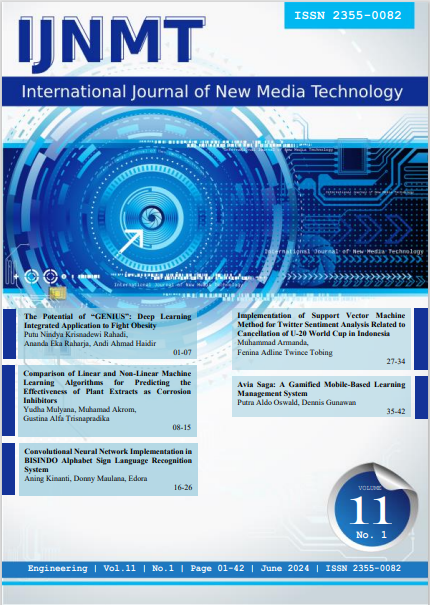Comparison of Linear and Non-Linear Machine Learning Algortima for Predicting the Effectiveness of Plant Extracts as Corrosion Inhibitors
DOI:
https://doi.org/10.31937/ijnmt.v11i1.3572Abstract
This research aims to develop a Machine Learning (ML) model that can predict the corrosion inhibitor potential of plant extracts with high accuracy. Corrosion is a serious problem in industry because it can reduce the service life of materials and cause economic losses. This research focuses on the use of green inhibitors, especially plant extracts, which are considered environmentally friendly and have high anticorrosion efficiency. The dataset used includes molecular and physicochemical features of plant extracts. The ML model development process involves data normalization, selection of linear and non-linear ML algorithms, model training with k-fold crossvalidation, and model performance evaluation using regression metrics such as MSE, RMSE, MAE, and R2. Experiments compare various ML algorithms and show that the AdaBoost Regressor (ABR) model exhibits the best prediction performance with the highest R2 value of 0.993 and a low MSE of 0.002. These results provide new insights into the potential of ML models to predict effective corrosion inhibitors from plant extracts. The ABR model had a low prediction error, indicating high accuracy in predicting corrosion inhibition efficiency. In addition, the analysis of important features shows that two features, Conc and LUMO, have a significant influence on the ABR model. This research makes an important contribution to the development of effective prediction methods in the corrosion control industry. The ABR model can serve as a basis for designing more effective and environmentally friendly corrosion inhibitor materials, as well as a reference for other researchers in developing ML models that accurately predict the corrosion inhibition efficiency of plant extracts.
Downloads
Additional Files
Published
How to Cite
Issue
Section
License
Authors retain copyright and grant the journal right of first publication with the work simultaneously licensed under a Creative Commons Attribution-ShareAlike International License (CC-BY-SA 4.0) that allows others to share the work with an acknowledgement of the work's authorship and initial publication in this journal.
Authors are able to enter into separate, additional contractual arrangements for the non-exclusive distribution of the journal's published version of the work (e.g., post it to an institutional repository or publish it in a book), with an acknowledgement of its initial publication in this journal.
Copyright without Restrictions
The journal allows the author(s) to hold the copyright without restrictions and will retain publishing rights without restrictions.
The submitted papers are assumed to contain no proprietary material unprotected by patent or patent application; responsibility for technical content and for protection of proprietary material rests solely with the author(s) and their organizations and is not the responsibility of the IJNMT or its Editorial Staff. The main (first/corresponding) author is responsible for ensuring that the article has been seen and approved by all the other authors. It is the responsibility of the author to obtain all necessary copyright release permissions for the use of any copyrighted materials in the manuscript prior to the submission.















